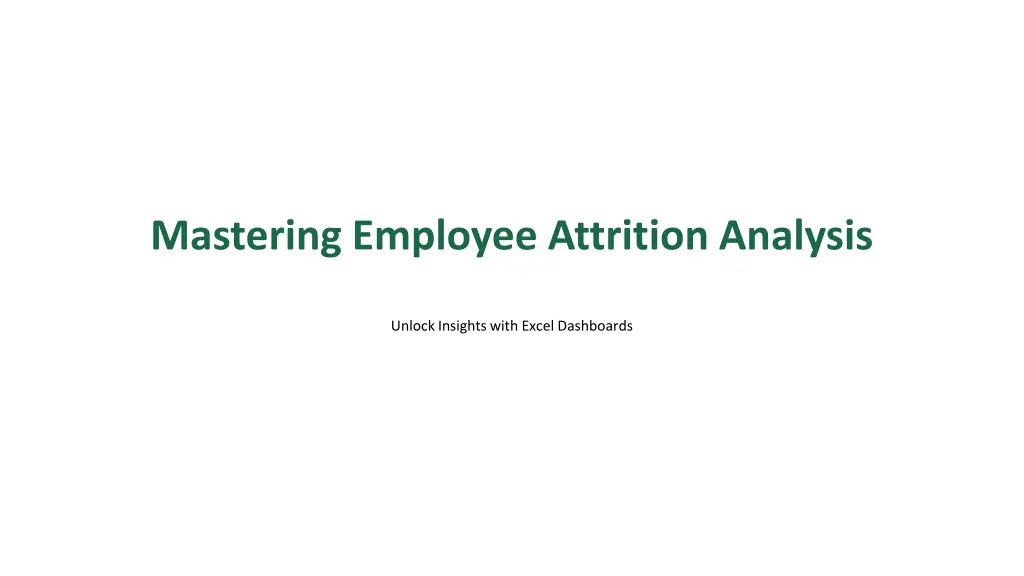
Unlock Insights on Employee Attrition with Excel Dashboards
Mastering Employee Attrition Analysis can provide valuable insights for businesses. Learn how to effectively use Excel to analyze attrition data, identify patterns, and implement retention strategies. With powerful tools and customizable dashboards, Excel enables real-time monitoring of key metrics such as turnover rates and employee engagement levels. Improve decision-making and save costs by addressing attrition effectively through this comprehensive guide.
Download Presentation

Please find below an Image/Link to download the presentation.
The content on the website is provided AS IS for your information and personal use only. It may not be sold, licensed, or shared on other websites without obtaining consent from the author. If you encounter any issues during the download, it is possible that the publisher has removed the file from their server.
You are allowed to download the files provided on this website for personal or commercial use, subject to the condition that they are used lawfully. All files are the property of their respective owners.
The content on the website is provided AS IS for your information and personal use only. It may not be sold, licensed, or shared on other websites without obtaining consent from the author.
E N D
Presentation Transcript
Mastering Employee Attrition Analysis Unlock Insights with Excel Dashboards
01 Understanding Employee Attrition Table of Contents 02 Why Use Excel for Attrition Analysis? 03 Key Metrics to Monitor 04 Creating Your Excel Dashboard 05 Visualizing Attrition Data 06 Identifying Patterns and Trends 07 Implementing Retention Strategies 08 The Power of Continuous Monitoring 09 Download the Dataset 10 Thank You!
1 Understanding Employee Attrition Employee attrition refers to the reduction in staff throughresignation, retirement, or termination. It's a critical metric that affects organizational performance and morale. Analyzing attrition helps identifytrends and issues within the workforce. Understanding reasons behindattrition can lead to better retentionstrategies. Addressing attrition effectively can save costs and enhance productivity.
2 Why Use Excel for Attrition Analysis? Excel provides powerful tools for data analysis and visualization. With dashboards, you can easily track attritionrates and identifypatterns. Excel s flexibility allows customization to fit specific business needs. Dashboards offer real-time access to critical data points and metrics. Using Excel can enhance decision-making and facilitate strategic planning.
3 Key Metrics to Monitor Monitor turnover rates, both overall and by department. Analyze factors like tenure, demographics, and performance levels. Examine exit interview data to find common reasons for leaving. Track hiring rates to understand the balance between attrition and recruitment. Assess employee engagement and satisfaction scores for insights.
4 Creating Your Excel Dashboard Start with a clean dataset that includes employee details and attrition data. Utilize Excel features like PivotTables to summarize large datasets. Incorporate charts and graphs for visual representation of data. Add slicers for interactivity, allowing users to filter data dynamically. Design the dashboard layout for easy navigation and readability.
5 Visualizing Attrition Data Use bar charts for comparing turnover rates across departments. Pie charts can illustrate the percentage of various reasons for attrition. Line graphs help track attrition trends over time. Heat maps can show areas with high turnoverwithin the organization. Effective visuals make data more accessible and actionable.
6 Identifying Patterns and Trends Look for correlations between attrition and employee demographics. Examine seasonal fluctuations in attritionrates. Identify departments with consistently high turnover. Recognize any links between engagement survey results and attrition. Trends can inform proactive measures to enhance retention.
7 Implementing Retention Strategies Use insights from analysis to devise targeted retentioninitiatives. Consider improving onboarding processes to enhance early employee experience. Develop career progression plans to increase employee engagement. Conduct regular feedback sessions to address employee concerns. Foster a positive workplace culture to reduce attrition.
8 The Power of Continuous Monitoring Regularly updatethe dashboard with fresh data for ongoing insights. Continuouslyanalyze new trends and adjust strategies accordingly. Encourage team participation in monitoring attrition metrics. Use the dashboardas a tool for accountability and improvement. Make data-drivendecisions a part of the organizational culture.
9 Download the Dataset Ready to get started? Download the dataset for practice. Follow along with the steps to create your own Excel dashboard. Experiment with different metrics and visuals to tell your story. Learning by doing enhances understanding and retention of concepts. Empower yourself with data analysis skills for the future.
10 Thank You! Thank you for exploring Employee Attrition Analysis with us. We hope you feel inspired to leverage data for impactfuldecisions. Remember, effective analysis leads to better retentionstrategies. Let s work together to transform the work environment positively. Feel free to reach out for furtherquestions or collaboration.
